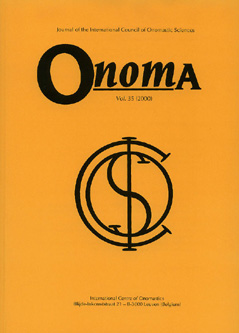 previous article in this issue previous article in this issue | next article in this issue  |

|
Document Details : Title: Cultural and Linguistic Layers Embedded in Romanian Oikonyms Derived from Hagionyms Author(s): FELECAN, Oliviu , FELECAN, Nicolae Journal: Onoma Volume: 48 Date: 2013 Pages: 89-107 DOI: 10.2143/ONO.48.0.3223615 Abstract : This study aims at highlighting the strong relationship between religion and oikonymy. The paper deals with the use of names of saints to designate certain Romanian settlements. The agent that unites the two fields and ensures their connection is the church, considered physically, as a place of worship that brings together people from a specific geographical area. As every place of worship is consecrated to a patron (such as Jesus, Blessed Virgin Mary or, more often, a saint of the calendar), the name of the patron can sometimes become the name of the settlement formed around the church, a situation that has frequently occurred throughout Europe. Although this system usually - but not exclusively - characterises parts of western Europe (like Italy, France, Spain and Portugal), it was also established in Romania, especially in Transylvania, via the influence of Catholicism. Interestingly enough, the structure of certain names of settlements allows us to distinguish a certain historical phase and even a linguistic and cultural phase, which can be related to the ever-increasing influence of the peoples who, in certain ages, established direct contact with the Romanian people or ruled over parts of the Romanian territory. In this respect, we cite examples of the lexemes used for the word sfânt ‘saint’: sânt (sân, sâm, inherited from Latin sanctus), sfânt (from Slavic sventŭ), Hungarian szent and German Sankt. To these forms, the names of saints are attached; the hagionyms occur as inherited variants, as elements of Slavic origin or as Hungarian and German variants (Nicoară/Nicola(i)e/Miklós; Sângeorz/Szent-György/Sankt-Georgen among others). More often than not, as a result of the dynamic nature of oikonyms, toponyms derived from the names of saints have been reduced to mere relicts or are unintelligible to most speakers. It is the aim of our study to uncover and explicate these aspects. Cet article a pour but de mettre en lumière la relation profonde entre religion et nom d’habitat. Il traite de l’utilisation des noms de saints pour désigner certains habitats en Roumanie. Le bâtiment de l’église, trait d’union entre ces deux domaines, est un lieu de culte qui rassemble des populations d’une zone géographique déterminée. Chaque lieu de culte étant consacré à un titulaire (Jésus, Vierge Marie ou, plus souvent, un saint du calendrier), le nom du titulaire peut parfois devenir le nom de l’habitat formé autour de l’église, phénomène fréquent dans toute l’Europe. Bien que ce système caractérise en général, mais pas seulement, l’aire de l’Europe occidentale (Italie, France, Espagne, Portugal…), il a aussi fonctionné en Roumanie, surtout en Transylvanie, par l’influence du catholicisme. En particulier, la structure de certains noms d’habitats permet de distinguer une phase historique, et même linguistique et culturelle, liée à l’influence croissante des peuples qui ont, à certaines époques, établi un contact direct avec le peuple roumain, sinon régné sur des parties de son territoire. À cet égard, nous pouvons citer des exemples de lexèmes usités pour sfânt ‘saint’: sânt (sân, sâm, issu du latin sanctus), sfânt (du slave sventŭ), hongrois szent et allemand Sankt. Les noms des saints usités sont alors conformes à ces langues (Nicoară/Nicola(i)e/Miklós; Sângeorz/Szent-György/Sankt-Georgen entre autres). Mais souvent, en fonction de la nature dynamique des noms d’habitats, les toponymes issus d’hagionymes ont été réduits à de simples vestiges, voire devenus inintelligibles de la plupart des locuteurs. Notre but est ici de découvrir et expliquer ces aspects. Der vorliegende Aufsatz setzt sich zum Ziel, den engen Zusammenhang zwischen Religion und Oikonymie zu verdeutlichen. Dafür wird der Gebrauch der Heiligennamen zur Benennung rumänischer Siedlungen untersucht. Der Faktor, der beide Bereiche miteinander verbindet, ist die Kirche als konkreter Ort der Verehrung, der Menschen aus einer bestimmten geographischen Umgebung zusammenbringt. Da jeder Verehrungsort einem Schutzheiligen gewidmet ist (so Jesus, der Muttergottes oder einem Heiligen aus dem Kalender), kann der Heiligenname zu einem bestimmten Zeitpunkt zum Namen der Siedlung in der Umgebung der entsprechende Kirche werden. Dieses Benennungsmuster hat sich überall in Europa vielfach wiederholt. In der Regel, aber nicht ausschließlich, ist ein solches Benennungssystem für Westeuropa charakteristisch (z.B. Italien, Frankreich, Spanien und Portugal). Es hat sich allerdings auch in Rumänien, insbesondere in Transsilvanien, durch den Einfluss des Katholizismus etabliert. Interessanterweise lässt die Struktur einer Reihe von Siedlungsnamen eine bestimmte historische, aber auch eine sprachliche und kulturelle Entstehungsphase erkennen. Solche Phasen können dem wachsenden Einfluss der Völker zugeordnet werden, die zu bestimmten Zeiten einen direkten Kontakt zu den Rumänen aufgenommen oder Teile des rumänischen Territoriums beherrscht haben. Diesbezüglich können Beispiele von Lexemen zum Wort sfânt 'Heiliger' genannt werden: sânt (sân, sâm, vom lateinischen sanctus), sfânt (von slavischem sventŭ), szent ungarischer Herkunft und Sankt deutscher Herkunft. Zu diesen Formen werden Heiligennamen hinzugefügt; die Hagionyme treten in ihrer ererbten rumänischen Form oder als Elemente ungarischer, slavischer oder germanischer Herkunft auf (u.a. Nicoară/Nicola(i)e/Miklós; Sângeorz/Szent-György/Sankt-Georgen). Als Ergebnis der dynamischen Entwicklung von Oikonymen wurden Ortsnamen von Heiligennamen häufig zu bloßen Relikten reduziert bzw. sie sind für die meisten Sprecher undurchsichtig. Der Aufsatz zielt darauf ab, solche Aspekte offenzulegen und zu erläutern. |
|
